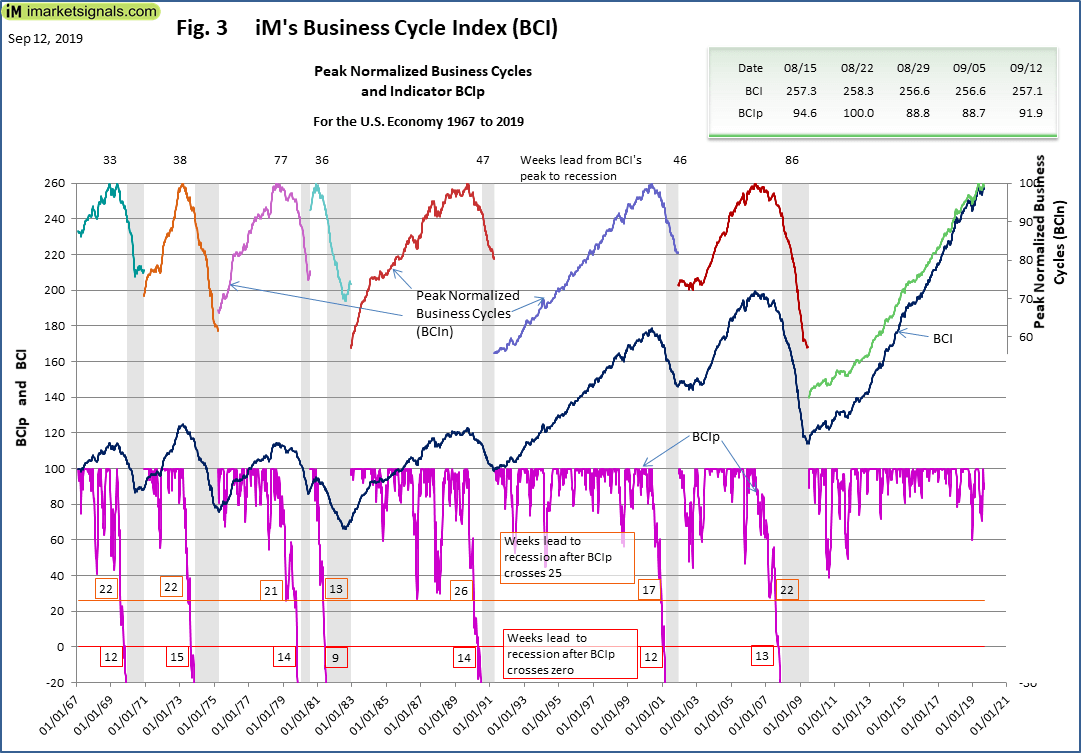No Sight Of Next Recession: Business Cycle Index Update - Sept. 12, 2019
Knowing when the U.S. economy is heading for recession is paramount to successful investment decisions. Our weekly Business Cycle Index would have provided early reliable warnings for the past seven recessions.
The BCI at 257.1 is up from last week's downward revised 256.6 and remains below the previous high of this business cycle indicated by the BCIp of 91.9. However, the 6-month smoothed annualized growth BCIg at 10.2 is below last week’s downward revised 10.4. Both BCIp and BCIg are not signaling a recession. (BCIp needs to drop below 25, or BCIg needs to drop to below zero).
(Click on image to enlarge)

Figure 1 plots BCIp, BCI, BCIg and the S&P 500 together with the thresholds (red lines) that need to be crossed to be able to call a recession.
The BCI was designed for a timely signal before the beginning of a recession and could be used as a sell signal for ETFs that track the markets, like SPY, IWV, VTI, etc., and switch into Treasury bond ETFs, like IEF, TIP, BND, etc. (see our article).
The BCI uses the below listed economic data and combines the components for the index in "real-time," i.e., the data is only incorporated into the index at its publication date:
- 10-year treasury yield (daily)
- Three-month Treasury bill yield (daily)
- S&P 500 (daily)
- Continued Claims Seasonally Adjusted (weekly)
- All Employees: Total Private Industries (monthly)
- New houses for sale (monthly)
- New houses sold (monthly)
The six-month smoothed annualized growth rate of the series is a well-established method to extract an indicator from the series. We use this method to obtain BCIg, i.e., the calculated growth rate with 6.0 added to it, which generates, on past performance, an average 11-week leading recession signal when BCIg falls below zero. Further, the index BCI retreats from its cyclical peak prior to a recession in a well-defined manner, allowing the extraction of the alternate indicator, BCIp (and its variant, BCIw), from which, on average, the 20-week leading recession signal is generated when BCIp falls below 25.
A more detailed explanation/description can be found here. Also, the historical values can be downloaded from iMarketSignals as an MS Excel sheet.
(Click on image to enlarge)

Figure 2 plots the history of BCI, BCIg and the LOG (S&P 500) since July 1967, and Figure 3 plots the history of BCIp, i.e., 46 years of history, which includes seven recessions, each of which the BCIg and BCIp managed to indicate timely; the weeks leading to a recession are indicated on the plots.
(Click on image to enlarge)

Disclaimer: The information provided is based on mathematical models using public available economic data. The charts depict the results of our models and are not influenced by any other factors ...
more



Good stuff, would like to see more by you.